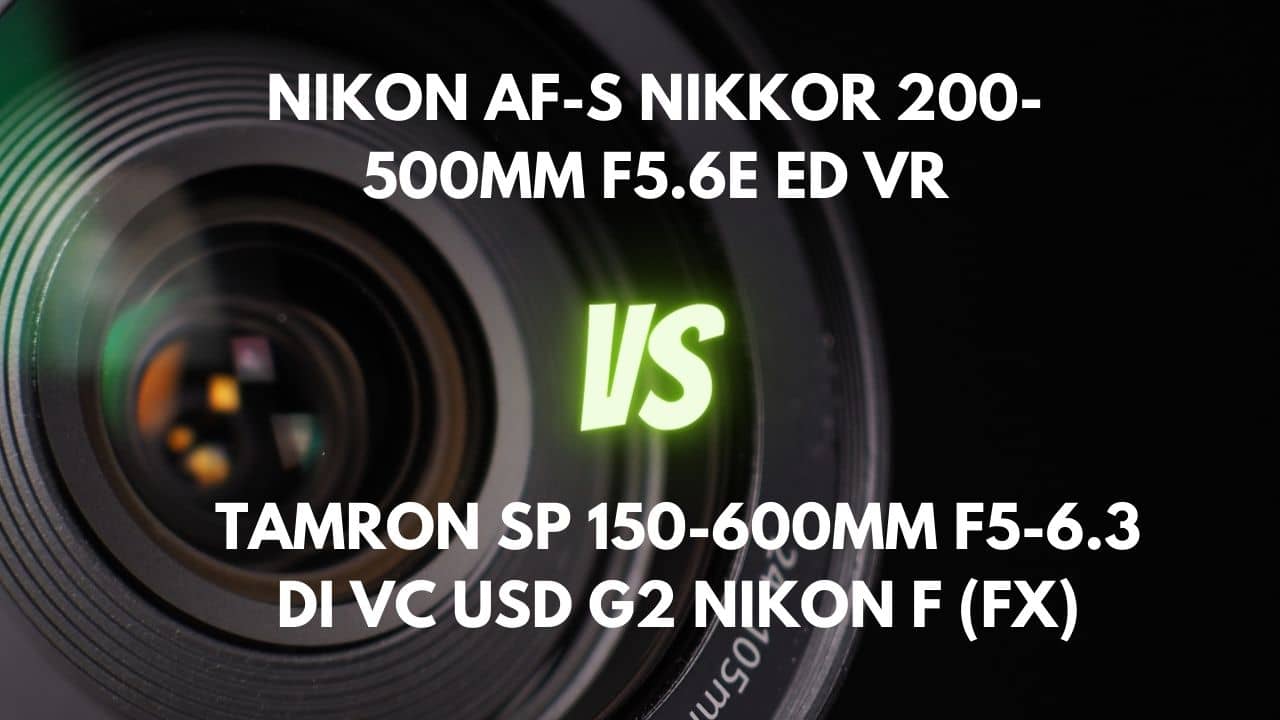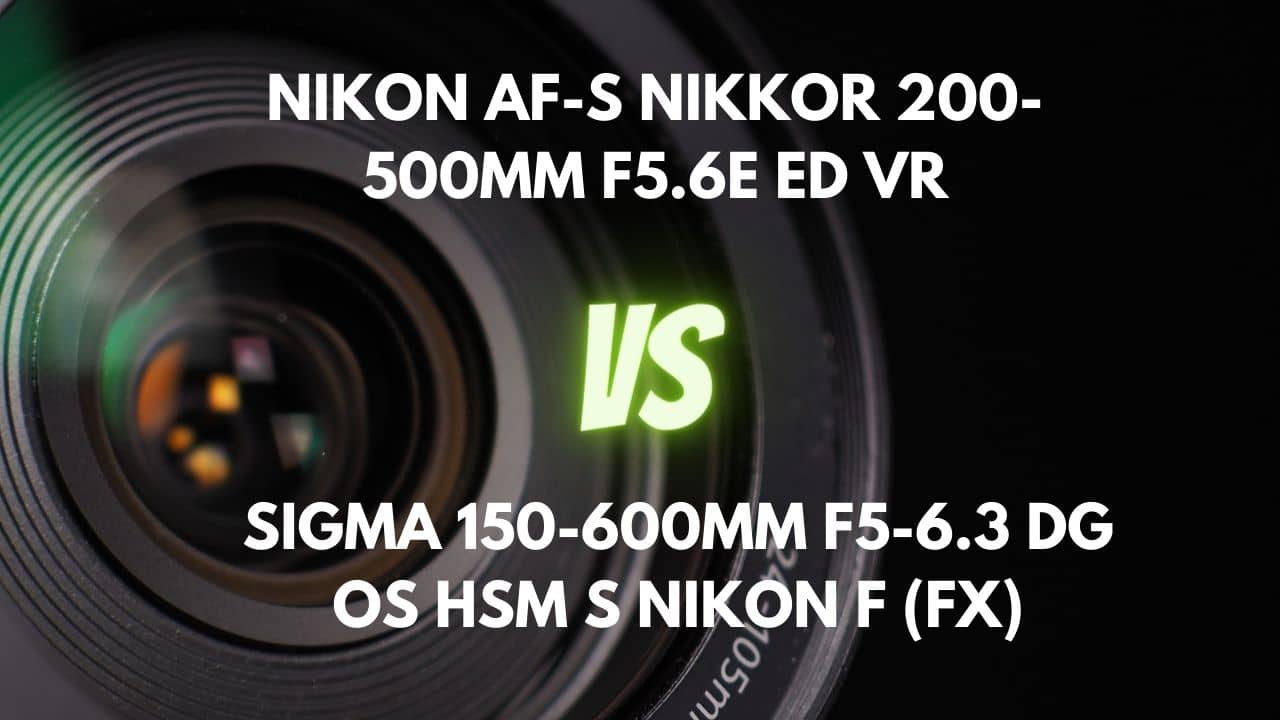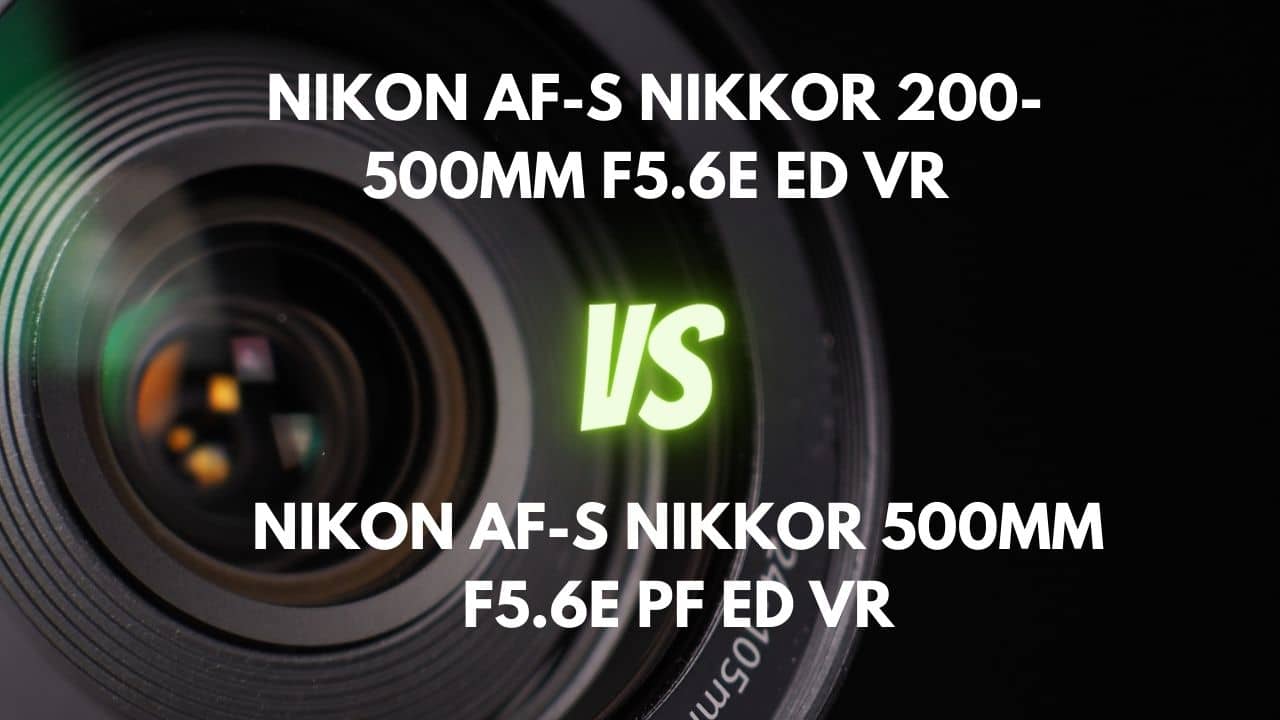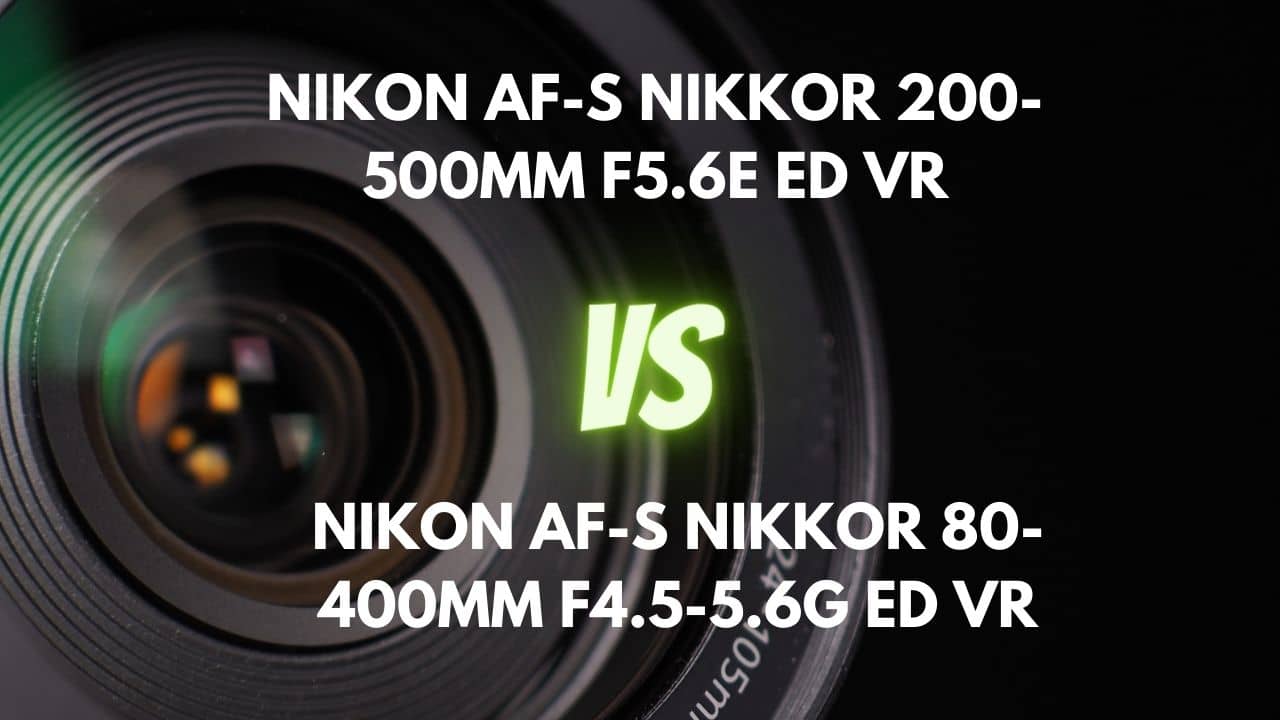Capturing stunning sports action or mesmerizing wildlife moments requires a high-quality telephoto lens that can keep up with the demands of these fast-paced scenarios.
As photographers, we’re always on the lookout for the perfect lens that offers the right balance between versatility, image quality, and cost-effectiveness. In the world of Nikon lenses, two standouts in the telephoto category are the Nikon AF-S NIKKOR 200-500mm F5.6E ED VR for DSLRs and the Nikon NIKKOR Z 100-400mm F4.5-5.6 VR S for mirrorless cameras.
While designed for different lens mounts, the 200-500mm can also be adapted for use on mirrorless cameras, making the comparison even more intriguing.
In this article, we’ll delve deep into the features and performance of these two telephoto giants, helping you decide which lens is the perfect companion for your sports and wildlife photography adventures.
So, buckle up and join us as we embark on this exciting journey of discovery!
Overview
| Nikon NIKKOR Z 100-400mm F4.5-5.6 VR S | Nikon AF-S NIKKOR 200-500mm F5.6E ED VR | |
|---|---|---|
| Max Aperture | F4.5-5.6 | F5.6 |
| Aperture Type | Variable | Fixed |
| Focal Range (mm) | 100-400 | 200-500 |
| Mount Type | Nikon Z | Nikon F (FX) |
| Zoom Ratio (X) | 4 | 2.5 |
The Nikon Z 100-400mm f/4.5-5.6 and the Nikon 200-500mm f/5.6 are both telephoto lenses with distinct features. The Z 100-400mm lens has a variable aperture of f/4.5-5.6, a focal range of 100-400mm, a 4x zoom ratio, and is designed for the Nikon Z mount. This lens offers greater versatility with its wider focal range and higher zoom ratio, making it suitable for various photography scenarios.
On the other hand, the Nikon 200-500mm f/5.6 has a fixed aperture of f/5.6, a focal range of 200-500mm, a 2.5x zoom ratio, and is designed for the Nikon F (FX) mount. The fixed aperture provides better low-light performance and consistent image quality across the zoom range. The lens also offers a longer focal length, which is beneficial for wildlife and sports photography.
The Nikon Z 100-400mm lens is a more versatile lens with a wider focal range and higher zoom ratio, making it suitable for various situations. It may have slightly reduced low-light performance and image quality due to its variable aperture. The 200-500mm lens, with its fixed aperture, offers better low-light performance and consistent image quality but is limited by its narrower focal range and lower zoom ratio.
The Nikon Z 100-400mm is a superior choice for photographers seeking versatility and a wider focal range, while the 200-500mm lens is better suited for those prioritizing low-light performance, consistent image quality, and a longer reach in their telephoto lens.
Design and Ease of Use
| Nikon NIKKOR Z 100-400mm F4.5-5.6 VR S | Nikon AF-S NIKKOR 200-500mm F5.6E ED VR | |
|---|---|---|
| Diameter x Length (mm) | ⌀98×222mm | ⌀108×267.5mm |
| Weight (gr) | 1355 | 2300 |
| Filter Thread (mm) | 77 | 95 |
| Weather Sealing | Yes | No |
| Zoom Method | Rotary (extending) | Rotary (extending) |
| Zoom Lock | Yes | Yes |
| Distance Scale | Yes | Yes |
| DoF Scale | Yes | No |
| Hood Supplied | Yes | Yes |
| Hood Code | HB-103 | HB-71 |
| Tripod Collar | Yes | Yes |
Lens Mount and Barrel
The Nikon Z 100-400mm f/4.5-5.6 and Nikon 200-500mm f/5.6 showcase differences in their lens mounts and barrels.
The Z 100-400mm lens mount is crafted from metal, giving it a robust feel, and features a rubber gasket to shield against dust and moisture. Its lens barrel comprises metal and plastic materials, with a finish resembling aluminum. An ergonomic bevel and a rotatable color collar add flair to the design. As an extending zoom lens, the Z 100-400mm barrel moves a short 80 degrees when zooming in or out.
In contrast, the 200-500mm lens mount also boasts a metal construction and a protective rubber gasket. The lens barrel is made of metal with a high-grade plastic shell, sporting stylish Nikon gold branding and white focal length markings.
Metal lens barrels generally offer superior durability and a premium feel compared to plastic barrels. However, they are often heavier and less portable. Plastic lens barrels, on the other hand, are lighter and more budget-friendly but may not be as durable. Many high-end lenses use a combination of metal and plastic materials to balance weight, durability, and cost.
Taking these factors into account, the Z 100-400mm lens mount and barrel offer a desirable balance of durability, style, and functionality. The extending zoom mechanism, ergonomic design, and rotatable color collar give it an edge over the 200-500mm lens, which still presents a solid build and professional appearance. Ultimately, the choice depends on your specific needs and preferences as a photographer.
Weather Sealing
The Nikon Z 100-400mm f/4.5-5.6 and Nikon 200-500mm f/5.6 exhibit differences in weather sealing, which is crucial for protecting the lens from dust, moisture, and light water splashes.
The Z 100-400mm lens boasts full weather sealing, complete with a rubber grommet at the lens mount and specialized sealing throughout its construction, even near the lens cap. Additionally, a fluorine coating on the front element helps resist dirt and smudges.
In contrast, the 200-500mm lens lacks full weather sealing, although a rubber gasket at the mount provides some protection against dust and moisture. However, there are no internal seals at the rings, switches, or front of the barrel, and the front element doesn’t have a fluorine coating.
Fully weather-sealed lenses offer better protection, durability, and performance in various conditions compared to non-sealed lenses. They are also more suitable for photographers who frequently shoot in challenging environments. However, fully weather-sealed lenses can be more expensive due to the additional engineering and materials required.
Overall, the Z 100-400mm lens has superior weather sealing compared to the 200-500mm lens. This makes the Z 100-400mm lens a more reliable choice for photographers who often shoot outdoors in various weather conditions and require better protection for their gear.
Rings
The Nikon Z 100-400mm f/4.5-5.6 and Nikon 200-500mm f/5.6 feature distinct ring designs that cater to different preferences and needs.
The Z 100-400mm lens sports 3 rings: a customizable narrow ring closest to the mount, a manual focusing ring in the middle, and a front zoom ring marked with focal lengths from 100 to 400mm. The 80-degree rotation angle of the zoom ring enables quick adjustments without altering grip or experiencing zoom creep.
The rings offer a ridged texture for a tactile experience, and the control ring has a dotted texture for easy identification. While the focusing ring has no hard stops, it can be adjusted using the display window and includes a focus limiter switch. The zoom ring is smooth and doesn’t have an extension lock switch.
In contrast, the 200-500mm lens has 2 rings: a wide zoom ring towards the front and a focus ring closer to the camera body. Both rings are covered in textured rubber for a tactile feel. The focus ring allows for precise focus acquisition, while the zoom ring requires a 180-degree rotation to zoom from 200 to 500mm, which some users may find inconvenient.
A lock switch on the zoom ring keeps it in place at 200mm. The focus ring has a focus limiter function and a 0.22x (1:4.5) magnification ratio, It has a windowed distance scale but lacks a depth-of-field indicator.
The Z 100-400mm lens has an edge over the 200-500mm lens in terms of ergonomics, ring placement, and quick adjustments, thanks to its 3-ring design, 80-degree zoom ring rotation, and customizable control ring. Meanwhile, the 200-500mm lens has a focus limiter function that some users may prefer.
In conclusion, the Z 100-400mm lens offers a more versatile and user-friendly ring design compared to the 200-500mm lens.
Switches/Buttons
The Nikon Z 100-400mm f/4.5-5.6 and the Nikon 200-500mm f/5.6 exhibit unique switch and button configurations, catering to different user preferences.
The Z 100-400mm lens boasts an array of switches and buttons. An AF/MF switch and a focus limiter switch are positioned towards the lens mount. Additionally, 2 pairs of L-Fn buttons, assignable to control various functions, are situated behind the zoom ring and the focusing ring. An OLED display reveals focus distance, aperture, and focal length, which can be toggled using the Disp button beside it. Moreover, unmarked buttons on the same ring replicate the setting assigned to the L-Fn2 button.
On the other hand, the 200-500mm lens houses 4 switches on its side. From top to bottom, these include a focus mode switch for shifting between autofocus with manual focus override and manual focus, a focus limiter switch for close focus to infinity (full range) and 6 meters to infinity, a vibration reduction mode switch for toggling between Normal and Active modes, and a zoom lock switch to secure the lens at its shortest position (200mm) for transportation and to prevent unwanted extension.
When comparing switch and button designs, consider the ease of use, functionality, customization, and user experience. The Z 100-400mm lens offers greater versatility and customization with its L-Fn buttons, OLED display, and additional unmarked buttons. Meanwhile, the 200-500mm lens provides a simpler layout with essential switches for focus mode, focus limiter, vibration reduction, and zoom lock.
In conclusion, the Z 100-400mm lens offers a more advanced and customizable switch/button layout compared to the 200-500mm lens. However, the final choice depends on individual preferences and the desired level of control and customization in a lens.
Filter Thread
The Nikon Z 100-400mm f/4.5-5.6 has a 77mm filter thread made of plastic material. This size is more common, offering a wider variety of filters at a reasonable price. The stationary filter thread does not rotate during focus, making it convenient to use with filters like polarizers or graduated ND filters. High-quality filters are recommended for optimal image quality with this lens.
On the contrary, the Nikon 200-500mm f/5.6 has a 95mm filter thread size, which is relatively uncommon. Compatible filters include the German brass 95mm B+W 010 UV MRC filter and the Japanese aluminum 95mm Hoya EVO UV, both of which boast dirt, dust, and smudge-resistant multicoatings for extended durability. The 95mm Hoya HMC filter is another option, but it lacks the crud-resistant coatings. Despite the filter size being less common, investing in a high-quality filter for this lens is advisable since filters can last a lifetime or more.
In conclusion, the Z 100-400mm lens offers a more common and convenient filter thread size (77mm) compared to the 200-500mm lens with its less common 95mm size.
Lens Hood
The Nikon Z 100-400mm f/4.5-5.6 and Nikon 200-500mm f/5.6 both come with unique lens hoods designed to shield the front lens element from stray light and protect it from potential damage.
The Z 100-400mm lens hood has a petal-shaped design and is made in Japan. It features a release button that may be hard to locate and press due to its flush position with the hood and the surrounding ribbed material. Nevertheless, the hood can be reversed when not in use, allowing for easy transport.
In contrast, the 200-500mm lens hood has a one-piece, plastic construction that attaches securely via a bayonet mount. The hood can also be reversed for convenient storage during transportation. This simple design is effective at its job, providing sufficient protection to the lens.
In conclusion, both lens hoods offer valuable protection and convenience, with the Z 100-400mm lens hood boasting a more visually appealing petal-shaped design and the 200-500mm lens hood providing a straightforward, functional one-piece design. However, the Z 100-400mm lens hood’s release button might be slightly more challenging to use compared to the simple bayonet mount on the 200-500mm lens hood.
Tripod Collar
The Nikon Z 100-400mm f/4.5-5.6 features a detachable tripod collar, which allows for flexible positioning around the lens and easy adjustments with a thumb screw. However, the collar is not compatible with Arca Swiss, necessitating additional accessories for some users. When removed, the collar leaves a protruding stub that can be slightly bothersome.
In contrast, the Nikon 200-500mm f/5.6 comes with a tripod collar designed to support its weight and provide stability on a tripod. The collar has a single connection point located far on the back of the lens barrel, which could be improved with a two-point stabilization system like those found in Kirk and RRS replacement lens collars.
Although not directly compatible with Arca-Swiss, many photographers choose to replace the stock collar with an aftermarket version offering better support and compatibility. The tripod collar can be removed for a more comfortable handheld experience.
In summary, the 100-400mm Z lens offers a more practical and adjustable tripod collar but lacks Arca Swiss compatibility. The 200-500mm lens could benefit from an improved stabilization system, but its removable collar offers a better handheld experience. Considering the overall design and functionality, the 100-400mm Z lens tripod collar is superior.
Focusing and Optical Stabilization
| Nikon NIKKOR Z 100-400mm F4.5-5.6 VR S | Nikon AF-S NIKKOR 200-500mm F5.6E ED VR | |
|---|---|---|
| Autofocus | Yes | Yes |
| AF Motor | Stepper motor | Silent Wave Motor |
| Rotating Front Element | Does not rotate on focusing | Does not rotate on focusing |
| Min Focus Distance | 0.75m(100mm);0.98m(400mm) | 2.2m |
| Max Magnification (X) | 0.38 | 0.22 |
| Full-Time Manual Focus | Yes | Yes |
| Focus Method | Internal | Internal |
Focusing Performance
The Nikon Z 100-400mm f/4.5-5.6 boasts fast, quiet, and accurate autofocus performance, making it well-suited for sports, wildlife, and action photography. Its two quiet stepping focus motors enable swift autofocus, taking about a quarter-second to go from one end to the other on Nikon’s fastest mirrorless body, the Z9.
The lens performs admirably in low-light situations but may occasionally hunt. It offers manual focus override and an internally focusing design, keeping the lens length constant and preventing the front element from rotating during focusing.
In comparison, the Nikon 200-500mm f/5.6 features a built-in Silent Wave Motor (SWM), ensuring quiet autofocus operation and allowing for full-time manual focus override. Its autofocus speed is impressive, with initial focus acquisition faster than many f/1.8 Nikon primes.
Low-light performance is generally decent, but it may slow down slightly at 500mm. The lens focuses accurately and consistently, with a smooth manual focus action and a wide focus ring. Like the 100-400mm Z lens, it has an internally focusing design, making it convenient to use with polarizing filters.
In conclusion, both lenses offer excellent focusing performance, with the 100-400mm Z lens providing slightly faster and quieter autofocus, while the 200-500mm lens offers impressive initial focus acquisition and consistent focusing.
Optical Stabilization
The Nikon Z 100-400mm f/4.5-5.6 is equipped with an optical image stabilization (OIS) system that delivers a 5-stop boost in handhold-ability when used with the in-body image stabilization (IBIS) of a full-frame Z camera body. Although it lacks external controls for stabilization, settings can be adjusted through the camera menu. The lens demonstrates impressive VR system performance, allowing for sharp results even at slower shutter speeds.
In contrast, the Nikon 200-500mm f/5.6 features a Vibration Reduction (VR) system offering up to 4.5 stops of stabilization, operating silently and providing two modes: Normal and Sport. The stabilization system performs admirably at slow shutter speeds, even at 500mm focal length.
In conclusion, both lenses offer effective optical stabilization, with the 100-400mm Z lens providing a slight advantage due to its 5-stop boost in combination with the camera’s IBIS. This makes it the superior choice for photographers seeking enhanced stabilization for handheld shooting and capturing sharp images at slower shutter speeds.
Image Quality
| Nikon AF-S NIKKOR 200-500mm F5.6E ED VR | Nikon NIKKOR Z 100-400mm F4.5-5.6 VR S | |
|---|---|---|
| Special Elements | 3 ED elements | 6 ED elements, 2 Super ED elements |
| Diaphragm Blades | 9 | 9 |
Aberration
Starting with the Nikon Z 100-400mm f/4.5-5.6, this lens exhibits very minimal chromatic aberration, both lateral and axial, thanks to the use of Super ED glass and ED glass elements, as well as Nano Crystal and ARNEO coatings to combat ghosting and flare. The lens produces minimal coma even when wide open, making it an excellent choice for night photography.
Spherical aberration is well-controlled, with no significant spherochromatism observed, and overall sharpness is highly impressive. However, there may be some slight focus shift towards the foreground, which becomes sharper faster than the background.
On the other hand, the Nikon 200-500mm f/5.6 showcases minimal chromatic aberration on extremely contrasted edges, even at a 200% crop. Lateral chromatic aberration levels are fairly low at 200mm and 300mm, but they start to worsen towards 400mm and reach 2.29 pixels at f/5.6 at 500mm, which is considered rather high.
In conclusion, Z 100-400mm lens outperforms 200-500mm lens in terms of aberration control. Thanks to its advanced glass elements and coatings, the Z 100-400mm lens delivers superior results with minimal chromatic aberration, coma, and spherical aberration, making it the better choice for photographers seeking optimal image quality with minimal optical distortions.
Sharpness
The Nikon Z 100-400mm f/4.5-5.6 boasts exceptional sharpness, delivering remarkable center sharpness and impressive corner sharpness that improves at f/6.3 and peaks at f/11. Although sharpness slightly softens at the edges in the 300-400mm sector, the lens maintains good control over aberrations and remains tack sharp in the center of the image, even at 400mm.
On the other hand, the Nikon 200-500mm f/5.6 exhibits excellent center sharpness throughout the zoom range, with some corner softness at longer focal lengths and wide open apertures that improve upon stopping down, often peaking around f/11.
In conclusion, both lenses offer outstanding sharpness, but the 100-400mm Z lens takes the lead with its superior corner sharpness and consistently sharp performance across the zoom range.
Bokeh Quality
The Nikon Z 100-400mm f/4.5-5.6 generates smooth and delightful bokeh, thanks to its 9 rounded aperture blades. While some cat’s eye-shaped highlights may appear towards the edges of the frame when used wide open, the overall bokeh remains pleasing. The character of the bokeh can vary depending on the distance between the subject and the background, resulting in a range of effects from melted backgrounds in macro shots to busier bokeh with more distant subjects.
In comparison, the Nikon 200-500mm f/5.6 also produces pleasing bokeh quality, with smooth and beautiful out-of-focus areas. Its 9 rounded aperture blades contribute to an attractive rendition of out-of-focus areas, effectively handling specular highlights and background isolation. The bokeh balls display very low longitudinal chromatic aberration, and the cat’s-eye effect is present but not too intrusive.
While bokeh evaluation is subjective, both lenses exhibit pleasing bokeh quality. However, the 200-500mm lens offers a slight edge with its effective handling of specular highlights, background isolation, and minimal chromatic aberration, making it the superior choice for photographers seeking beautiful bokeh in their images.
Flare/Ghosting
The Nikon Z 100-400mm f/4.5-5.6 demonstrates strong performance in reducing flare and ghosting. Employing multiple coatings, such as Nano Crystal and ARNEO coatings, it effectively combats ghosting and flare, even when shooting directly into bright light sources. The lens hood also aids in minimizing these artifacts. Although some ghosting artifacts and veiling glare may occur when the light source is inside the frame, they do not pose significant issues overall.
On the other hand, the Nikon 200-500mm f/5.6 exhibits good flare-resistance, but flare and ghosting can still be problematic if a strong light source is directly in the frame or near the edge of the image. Nevertheless, if the light source is clearly outside the image frame, no artifacts are produced. The flare patterns generated by this lens are simple and free of additional coloration. It’s essential to be cautious of strong light sources directly outside the frame, but aside from that, the flare and ghosting performance is good.
Comparatively, the 100-400mm Z lens appears to have superior flare and ghosting resistance due to its advanced coatings and effective lens hood. While the 200-500mm lens still performs well in many situations, the 100-400mm Z lens offers an edge in mitigating these artifacts, making it the better choice for photographers who frequently shoot in challenging lighting conditions.
Vignetting
The Nikon Z 100-400mm f/4.5-5.6 exhibits vignetting, particularly at 400mm and f/5.6. Despite this, the issue can be easily corrected during post-processing and seldom poses problems in real-world shooting scenarios.
In contrast, the Nikon 200-500mm f/5.6 demonstrates impressive control over vignetting. Only minor darkening of the edges is observed at focal lengths beyond 300mm when focused at infinity. At shorter focal lengths, vignetting is virtually non-existent. While some vignetting is present, it can be easily addressed in post-processing and often contributes a charming quality to the images.
Comparing the two lenses, the 200-500mm lens exhibits superior control over vignetting, especially at longer focal lengths. Although the 100-400mm Z lens does experience some vignetting at 400mm, it is not a major issue and can be resolved in post-processing.
Distortion
The Nikon Z 100-400mm f/4.5-5.6 exhibits a slight pincushion distortion at 100mm, which becomes more noticeable and consistent throughout the 200-400mm zoom range. Despite this, the distortion is relatively minor and easily corrected. With built-in lens profile applied to RAW or in-camera JPGs, distortion compensation works effectively. Overall, the lens performs well in terms of distortion control, even when shooting subjects with very straight lines.
On the other hand, the Nikon 200-500mm f/5.6 demonstrates minor pincushion distortion across various settings and distances. However, it is typically not noticeable in real-world situations. Most Nikon DSLRs can automatically correct this distortion, and if not, it can be easily removed using post-processing tools, such as Photoshop’s Lens Distortion tool. Despite the minor imperfections, the lens produces sharp images with minimal linear distortion. In general, distortion is manageable and easily corrected in post-processing.
When comparing the two lenses, both exhibit minor pincushion distortion, but the 100-400mm Z lens have slightly better control over distortion, especially when shooting subjects with straight lines.
Final Verdict
In conclusion, the Nikon Z 100-400mm f/4.5-5.6 excels in versatility, build quality, weather sealing, autofocus performance, optical stabilization, aberration control, sharpness, flare/ghosting resistance, and distortion control.
On the other hand, the Nikon 200-500mm f/5.6 has an advantage in low-light performance, consistent image quality, bokeh quality, and vignetting control.
If you prioritize versatility, durability, and superior overall performance in various aspects, the Z 100-400mm lens is the better choice. However, if low-light performance, consistent image quality, beautiful bokeh, and better control over vignetting are more important to you, the 200-500mm lens is the way to go.






